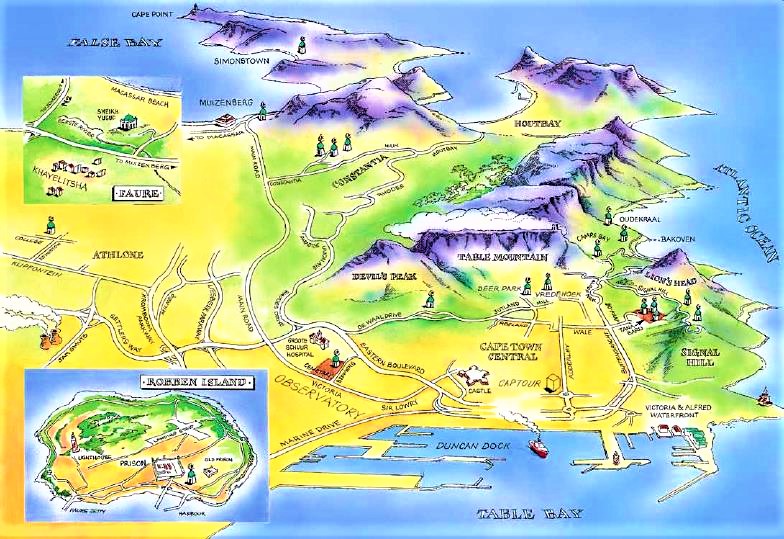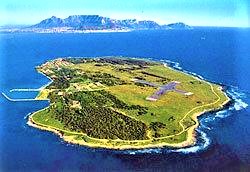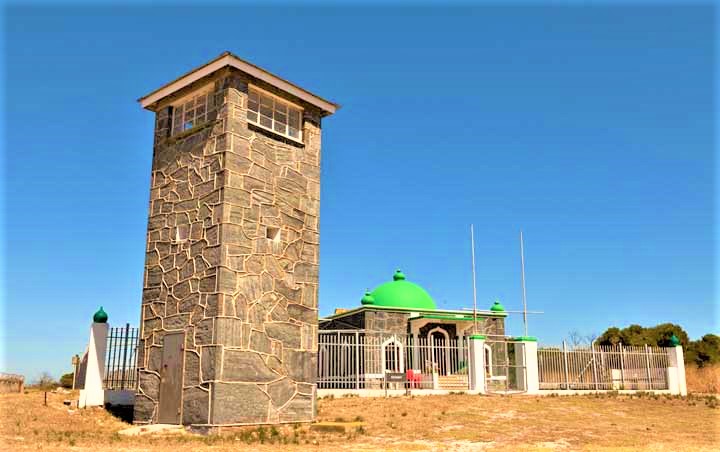The “Circle of Peace and Tranquility”: The Karamat of Sheik Sayed Abduraghman Motura (Part 1)
TRANSCEND MEMBERS, 8 Aug 2022
Prof Hoosen Vawda – TRANSCEND Media Service
6 Aug 2022 – This series of publications narrate the history behind the holy Islamic mausoleums or Karamah in the Western Cape, South Africa, highlighting the important graves of Islamic holy men buried therein, over the past 300 years. These Islamic “Saints” have made significant contribution to the propagation and maintenance of everlasting peace and tranquility in the midst of ever increasing numbers of “peace destructors’, not only in Africa, but the rest of the world, as well.Humanoids Are in Regular Pursuit of Materialism at the Expense of Inner Tranquility, Peace and Excellence in Health [i]
At this point, it is appropriate to discuss the term “Karamat”, elucidating the diverse contexts in which it is used depending on which part of the world it is used, to describe Islamic entities. and the varied meaning of the term. In Sunni Islam[3], which is the largest denomination of Islam, globally, comprising 85-90%of all Muslims, the name Sunni originates from the Islamic word Sunnah, meaning the traditions of the Prophet Muhammad of Islam. The second largest sub-division of Muslims is the Shia[4] In this context the term karamat literally means. generosity, high-mindedness[5] and refers to supernatural wonders performed by Muslim saints, and pious sages throughout history. In the technical vocabulary of Islamic religious sciences, the singular form “karama” has a sense similar to charism, a favor or spiritual gift freely bestowed by God.[6] The marvels ascribed to Muslim saints have included supernatural physical actions, predictions of the future, and “interpretation of the secrets of hearts”.[7] The concept is closely related to that of “Barakah” or divine blessing, which endows the individual with such abilities.[8] The word itself seems to be a loan word from Persian[9] or Caucasian language.[10] Keremet is a demi god of miracles in the Mari[11] theology in Caucasian region. Historically, a “belief in the miracles of saints “karāmāt al-awliyā”, literally ‘marvels of the friends of God]'” has been a part of Sunni Islam.[12] This is evident from the fact that an acceptance of the miracles wrought by saints is taken for granted by many of the major authors of the Islamic Golden Age (ca. 700–1400),[13] as well as by many prominent late-medieval scholars. According to orthodox Sunni doctrine, all miracles performed by saints are done by the leave and specific permission of God, and usually involve a “breaking of the natural order of things” k̲h̲āriḳ li’l-ʿāda,” [14]or represent, in other words, “an extraordinary happening which breaks the ‘divine custom’ of sunnat Allāh, which is the normal course of events.” Traditionally, Sunni Islam has also strictly emphasized that the miracle of a saint, however extraordinary it may be, is never in any way the “sign of a prophetic mission,” and this has been stressed in order to safeguard the Islamic doctrine of Muhammad being the Seal and the last of the Prophets, in Islam.[15]
The doctrine of the karāmāt al-awliyāʾ[16], which became enshrined as an orthodox and required belief in many of the most prominent Sunni creeds of the classical era such as the Creed of Tahawi (ca. 900)[17] and the Creed of Nasafi (ca. 1000),[18] emerged from the two basic Islamic doctrinal sources of the Quran and the hadith[19]. As the Quran referred to the miracles of non-prophetic saintly people like Khidr (18:65–82), [20]the disciples[21] of Jesus (5:111–115), [22]and the People of the Cave (18:7–26),[23] amongst many others, many prominent early scholars deduced that a group of venerable people must exist who occupy a rank below the prophets but who are nevertheless capable of performing miracles.[24] The references in the corpus of hadith literature to bona fide miracle-working saints like the pre-Islamic Jurayj̲ [25](seemingly an Arabic form of the Greek Grēgorios),[26] only lent further credence to this early understanding of the miracles of the saints. The fourteenth-century Hanbali scholar Ibn Taymiyyah (d. 1328), in spite of his well-known objections to the visiting of saints’ graves, nevertheless stated: “The miracles of saints are absolutely true and correct, by the acceptance of all Muslim scholars. The Qur’an[27] has pointed to it in different places, and the sayings of the Prophet have mentioned it, and whoever denies the miraculous power of saints are only people who are innovators and their followers.”[28] As one contemporary scholar has expressed it, practically all of the major scholars of the classical and medieval eras believed that “the lives of saints and their miracles were incontestable.”[29]
In the modern world, this doctrine of the miracles of saints has been challenged by certain movements within the branches of Salafism, Wahhabism, and Islamic modernism, as certain followers of some of these movements have come to view the very idea of Muslim saints “as being both un-Islamic and backwards, rather than the integral part of Islam which they were for over a millennium.”[30] Islamic modernists, in particular, have had a tendency to dismiss the traditional idea of miracles of saints as “superstitious” rather than authentically Islamic.[31] Despite the presence, however, of these opposing streams of thought, the classical doctrine continues to thrive in many parts of the Islamic world today, playing a vital role in the daily piety of vast portions of Muslim countries like Pakistan, Egypt, Turkey, Senegal, Iraq, Iran, Algeria, Tunisia, Indonesia, Malaysia, and Morocco,[32] as well as in countries with substantive Islamic populations like India, China, Russia, and the Balkans.[33]
However, in the context of the Islamic Cape Malay population, which has a long and illustrious history of important heritage contributions to the ancient and present history as well as the religious composition of the “Rainbow Nation[34]:” of South Africa, a positive, descriptive term created and used by the late Emeritus Archbishop Desmond Mpilo Tutu[35], to describe the varied phenotypes of the people of South Africa, post 1994. The term Karamat has a different connotation, in the authors personal opinion, based on his numerous visits to the Western Cape and interactions with the people whose ancestors had been residing there, for millennia. In Western Cape the term Karamat refers to the physical collection of a large number of burial places nd graves, which have been transformed into religious shrines and sanctuaries of peace, as well as tranquility, of the enlightened individuals, belonging to the Islamic faith, who arrived there centuries ago, died and were buried in the different parts of the region, including the infamous Robben Island, where the former President of South Africa, Nelson Mandela was incarcerated for nearly 27 years[36]
It is also interesting to note that if the regional layout of the map of these Karamah or shrines is examined, by the author and others, it forms a “Circle of Peace”, with the shrine on Robben Island completing the circle. Various miracles, including healing of the sick, amongst numerous other “divine interventions” are attributed to these Karamah, over the centuries they are in existence. It is also relevant to note that numerous local, national and international visitors have benefitted from the miracles attributed to the Islamic “friends of Allah’ God, interred therein, through their pious intercessions with the Supreme Almighty to assist the believers. These divine gifts are analogous to the sick visiting Lourdes [37]in the French Pyrenees[38], where St Bernadette encounters with the apparition of the Holy Mother[39] occurred on numerous occasions, initially in 1858, with the “Holy Waters”, attributed with therapeutic properties, gushed forth miraculously after St Bernadette knelt down to pray. The author has also visited Lourdes and can vouch for the medical cures, both of a spiritual, as well as a physical nature, documented, as genuine, after being subjected to stringent criteria for inclusion as miracles, defying science, by The Medical Bureau of the Sanctuary, Lourdes, in their medical museum.[40]
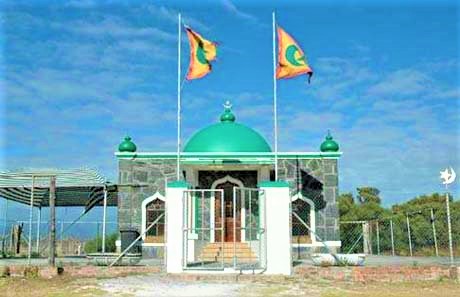
Present day view of the Karamat or Mausoleum of “Saint”, Sheik Sayed Abduraghman Motura, Robben island, off the shores of Cape Town built in 1969 by the apartheid Government of South Africa
Robben Island has become synonymous with the name Nelson Mandela, having spent 27 years of his life in prison there. However, very little is known of many other prisoners who have spent their better part of their lives on the island, for the same reason of seeking justice, peace and equality for their people. In fact, many prisoners died on the island and are buried there, today, their graves and mausoleums bear testimony to their existence on the island. One such man is the foremost pioneer of Islam at the Cape, Tuan Matarah commonly known as Sheik Sayed Abduragman Motura. He was a Sultan, well learned muslim teacher, leader and resistance fighter who was turned into a political prisoner in the late 1700. He resisted the colonisation by the Dutch in Indonesia and was subsequently banished to the Cape of Good Hope. Today his shrine on the island is a symbol of the pain and suffering convicts and slaves had to endure at the Cape, under foreign invasion and occupation. These present-day heritage sites, remind any modern day Capetonian Muslim of their identity and proud heritage that has existed over the past 300 years. The Karamat of Sheik Sayed Abduraghman Motura on Robben Island is an integral part of the circle of Kramats in Cape Town. This Circle of Peace is made of a number of mausoleums to Muslim holy men buried in and around Cape Town. Legend goes that it is this circle that protects Cape Town from earthquakes and national, natural disasters.[41] These Karamats, also called or Mazaars, in Islam, are the resting places, as the holy shrines of Islam and mark the graves of Holy Men of the Muslim faith who have died in and around the Cape. There are more than 20 recognised karamats in the Peninsula area, with at least another three in the outlying districts of Faure, Caledon, Rawsonville and Bains Kloof, in the Western Cape[42]
The history of the Mazaars begins with the Dutch invasion of places such as India, Ceylon and Java. Local communities resisted the tyranny but their leaders were banished to the Cape. Citizens of Malay, Indian, Javanese, Bengalese and Arabian origins were also sold into slavery during this time, and these slaves and banished, princes, sultans and other important individuals of foreign courts and kingdoms started the first Islamic communities in the Cape. It was only during the British occupation that the first mosque was permitted to be built, in South Africa.
The positioning of the karamats is said to fulfil a 250-year-old prophecy that a “circle of Islam” will be formed around Cape Town. This circle starts at Signal Hill [43]in Cape town with four separate karamah, continues to the site at Oude Kraal, then Constantia, and further to the famous karamat of Sheikh Yusuf at Faure, Macassar. The old tomb of the Sheik Motura, on Robben Island, completes the circle.
The infamous Robben Island first gained notoriety as a prison for eastern political exiles, sultans, spiritualists, convicts and slaves. It is a reminder of the injustices and the ill-treatment afforded these prisoners that a Karamat is to be found on the island. The eastern political exiles and convicts are truly the pioneers of Islam in this country, thus Robben Island becomes very much a part of history of the Muslims in South Africa. The shrine on Robben Island, is a symbol of the struggle for the establishment of Islam. It is an expression of Islam’s power, having survived all kinds of restrictions, prejudices, imprisonment and oppression in the land called ‘the fairest Cape on the circumference of the earth.’ Ironically, this shrine itself was constructed over the grave of the saint, by the apartheid prison authorities and officially opened on 11th May1969, as an appeasement to the Muslims for the incarceration and murder of the pious and highly respected political activist, Islamic religious cleric, Imam Abdullah Haron[44], in Cape Town, by the security apparatus of the South African, White minority, apartheid government.
Tuan Matarah, also known as Sayed Abduraghman Motura was reputed to have been a very learned and religious man. He spread the message of Islam and consoled those experiencing difficulties. He was known for his wonder cures and the comfort be brought to his fellow prisoners when they were ill. Tuan Matarah died on Robben Island. Upon his death, his grave soon became a respected shrine. Those who knew him, came to meditate and seek consolation for their suffering. Their example was followed by other prisoners who arrived after his death. On their release, they talked extensively about the holy man who lies buried on Robben Island.
A Kramat, also known as Durga, is a typically South African shrine which honours a holy person of Islam. This particular Kramat was built from 1967 to 1969, over the grave of Sayed Abdurahman Motura, a political prisoner brought to the Cape from Batavia, in the 18th century.
The Kramat is sited a short distance to the northwest of the Maximum-Security Prison, on the island itself. One of the tall MSP watchtowers was constructed very close to the Sheik’s grave, but the watch tower is now part of the existing context and landscape of the Karamat. The Karamat was opened in 1969 and has certain similarities to the design of the Sayed Muhammad Hassan Ghaibi Shah [45]Kramat, on Signal Hill, Cape Town.
Architecturally, the Sheik Sayed Abdurahman Motura Kramat is a simple square building with the walls constructed from Robben Island blue-green slate using the ‘permanent shutter’ construction technique utilised for the construction of the adjacent Maximum Security Prison. It is perhaps not unlikely that the construction work for the Kramat was carried out by the Convict building team, but this remains to be confirmed.
The inner ‘shutter’ was a 230 mm thick double-brick wall. The outer ‘shutter’ was made of slate slabs (typically about 150 mm thick) quarried on Robben Island. As the wall structure progressed upwards, the resultant cavity between the two shutters was filled with concrete. The external walls are characterised by the irregular outlines of the large stones, the close fit between adjacent stones, the raised ribbon pointing and the flat pilasters at the building corners.
The Karamat is surmounted by a flat concrete slab with a large central dome and four smaller domed finials at the building corners, all of which were topped with a star and crescent symbol. A circular opening in the slab and the spherical underside of the concrete dome are visible from below. The flat slab is supported on a set of four primary down-stand beams forming a square around the edges of the circular opening, the square rotated such that the corners of the structural square are coincident with the midpoints of each of the four walls below. Secondary down-stand beams connect across the inner four corners of the square so forming an octagonal frame to the circular opening and imposing a complex geometry over the space. The edge of the Karamat roof slab has been decorated with a plaster molding and the doors and windows all have simple, molded plaster surrounds. The entrance door is protected with a cantilevered concrete canopy supported on two brackets and is approached via a short flight of steps flanked by two flower boxes. The entrance door and windows are formed into Moorish arches. The entrance door is half-glazed and the windows are wooden four-paned casements with fanlights. The internal window sills are formed of golden-brown face bricks on edge. The interior walls are plastered and painted with minor damage from water leakage.[47]
A commemorative plaque with white text and a yellow frame, erected by the Cape Mazaar Society and mounted on the inside wall opposite the door into the Kramat, records the following inscription:
SAYED ABDURAHMAN MOTURA (R.A.)
Arrived in South Africa as a political prisoner from the Batavian Republic. He was banished to Robben Island where he lived for 11 years and passed on in January 1744.
A second commemorative plaque, in grey granite with engraved white lettering and a yellow painted plaster frame is mounted centrally on the northern internal wall. The plaque records the following inscription:
IN HONOUR OF SAYED ABDURAHMEN MOTURA
THIS DURGA WAS CONSTRUCTED WHEN ADVOCATE C. R. SWART [48] WAS PRESIDENT OF THE REPUBLIC OF SOUTH AFRICA
DONORS AND HELPERS: GENERAL J. C. STEYN COMMISSIONER OF PRISONS, COL. P. A. KELLERMAN AND STAFF, SHEIK SAYED AHMED KADERI AND HIS CONGREGATION
ROBBEN ISLAND 11 TH MAY 1969
A translation into Afrikaans, the second official language of the White Minority in the apartheid South Africa at the time, is also included in this plaque
A significant feature of the Karamat is the low rectangular plinth marking the grave site. The Karamat was sited to relate the entrance door axially with the narrow end of the plinth and the dome was centralized directly over it.
The walls of the plinth were originally constructed in a golden-brown face brick laid in stretcher bond with the top of the low plinth wall capped with square quarry tiles (subsequently painted white). A low decorative metal railing with rounded and curvilinear geometries, fabricated from a narrow round bar was installed around the inner edge of the quarry tile capping. A narrow apron formed with a single row of matching quarry tiles surrounded the plinth. A small white plaque was mounted on the plinth wall facing the door. This plinth arrangement was still extant in 1996. The plinth walls have however, since been clad with rectangular dark grey polished granite tiles. The top of the plinth walls were clad with matching polished granite slabs A low chrome-plated geometric steel railing, with round posts surmounted by spherical finials, was mounted on the top face of the granite capping. A raised granite tiled apron surrounds the plinth.
A commemorative inscription is applied onto the vertical granite tiled face of the plinth – facing the entrance door, which reads:
SHEIK SAYED ABDURAGHMAN MOTURA (R. A.)
Behold verily on the friends
Of Allah there is no fear
Nor shall they grieve
Those who believe
And (constantly) guard
Against evil
When the Kramat was constructed, a small walled area existed behind the building which contained two headstones. These were probably the graves of other Muslims exiled from the East. The body of Pangerau Chakra Deningrat, the Prince of Madura, who died on the island in 1754, was subsequently returned to Indonesia. (Bassett, B.W. & Rudner, J., Robben Island: An annotated survey of buildings and sites of architectural, historical and contextual importance, and recommendations concerning a conservation policy for the island. January 1986. NMC).
A formalised square precinct has more recently been defined around the Karamat utilising a standard galvanised palisade fence and surfacing the area with concrete. The entrance gate into the precinct is sited on axis with the entrance door to the Karamat and is flanked by two brick pillars. Each of the corners of the precinct is also defined with similar brick piers. A single grave is located within the south west quadrant of the Karamat precinct.
An Islamic ablution facility, comprising a freestanding wall with a few water points – was built in the north eastern corner of the Karamat precinct. An informal skeletal metal structure has also been incrementally erected within the outdoor precinct over which tarpaulins are draped to form temporary covered areas during different, Islamic religious ceremonies.
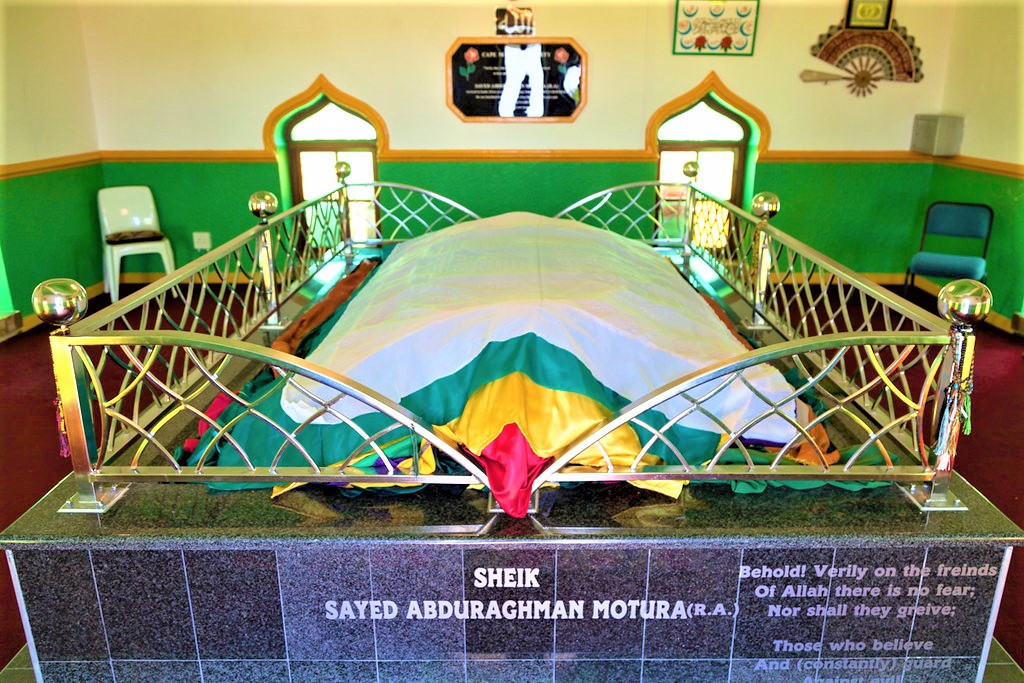
The actual grave of the Islamic, Saint Sheik Sayed Abduraghman Motura, where he was buries in 1754 inside the shrine in Robben island
The Bottom Line is a statement of significance concerning Robben Island[49], which has a long, sordid history as a remote and inaccessible site for incarcerating political dissidents at various times in South Africa’s history. The Karamat represents a tangible link to the early Muslim leaders who were kept here against their will by the Dutch. The building is an interesting alternative example of the construction technique developed by the South African Prison Service to build the external walls of the Maximum-Security Prison.[50] The Karamat remains a functional site of regular and ongoing religious prayers and pilgrimages by local members of the Muslim community as well as national and international tourists. After 1994 Robben Island, in its entirety is a heritage site, as well as a museum to remind future generations of the stark reality of the sad past of this island, never to be forgotten by humanity.
However, the island has achieved redemption from its tyrannical history, under the Dutch, British and the apartheid, nationalist government of South Africa from 1948 to 1994, whereby it is transformed into an integral part of the greater circle of peace. Here, since 1994, the Lord’s name is proclaimed regularly and the former notorious Robben Island has become a centre of peace and tranquillity. This transformation also demonstrates that no tyranny can last forever.
References:
[1] Personal quote by author August 2022
[2] http://capemazaarsociety.com/book.pdf
[3] https://en.wikipedia.org/wiki/Sunni_Islam
[4] https://en.wikipedia.org/wiki/Shia_Islam
[5] https://en.wikipedia.org/wiki/Karamat#:~:text=Hans%20Wehr%2C%20J.%20Milton%20Cowan%20(1979).%20A%20Dictionary%20of%20Modern%20Written%20Arabic%20(4th%C2%A0ed.).%20Spoken%20Language%20Services.
[6] “Karāma”, in: Encyclopaedia of Islam, Second Edition, Edited by: P. Bearman, Th. Bianquis, C.E. Bosworth, E. van Donzel, W.P. Heinrichs.
[7] https://en.wikipedia.org/wiki/Karamat#:~:text=%E2%80%9CKar%C4%81ma%E2%80%9D%2C%20in%3A%20Encyclopaedia%20of%20Islam%2C%20Second%20Edition%2C%20Edited%20by%3A%20P.%20Bearman%2C%20Th.%20Bianquis%2C%20C.E.%20Bosworth%2C%20E.%20van%20Donzel%2C%20W.P.%20Heinrichs.\
[8] Ernst, Carl W. (1997). The Shambhala Guide to Sufism (1st ed.). Boston, Massachusetts: Shambhala. p. 68. ISBN 9781570621802.
[9] https://en.wikipedia.org/wiki/Persian_language
[10] https://en.wikipedia.org/wiki/Caucasian_race
[11] https://www.bing.com/search?q=Keremet+is+a+demi+god+of+miracles+in+the+Mari&qs=n&form=QBRE&msbsrank=0_1__0&sp=-1&pq=keremet+is+a+demi+god+of+miracles+in+the+mari&sc=1-45&sk=&cvid=127F88FCFE2446BB9F6A2CCCFCADAD6E&ghsh=0&ghacc=0&ghpl=#:~:text=of%20the%20Keremet%3F-,These%20%E2%80%9CPeople%20of%20the%20Keremet%E2%80%9D%2C%20as%20the%20pagans%20were%20sometimes%20known%2C%20were%20able%20to%20survive%20alongside%20Christianity%2C%20because%20their%20faith%20wasn%E2%80%99t%20one%20of%20constant%20%E2%80%94%20daily%20prayers%20and%20weekly%20church%20services%2C%20for%20example%20%E2%80%94%20but%20one%20that%20was%20used%20to%20solve%20specific%20problems.,-The%20Mysterious%20Mari
[12] Jonathan A.C. Brown, “Faithful Dissenters,” Journal of Sufi Studies 1 (2012), p. 123
[13] Radtke, B., Lory, P., Zarcone, Th., DeWeese, D., Gaborieau, M., F.M. Denny, Françoise Aubin, J.O. Hunwick and N. Mchugh, “Walī”, in: Encyclopaedia of Islam, Second Edition, Edited by: P. Bearman, Th. Bianquis, C.E. Bosworth, E. van Donzel, W.P. Heinrichs.
[14] https://flickriver.com/photos/90250231n0510041136096/37019648895/
[15] https://en.wikipedia.org/wiki/Karamat#:~:text=Gardet%2C%20L.%2C%20%E2%80%9CKar%C4%81ma%E2%80%9D%2C%20in%3A%20Encyclopaedia%20of%20Islam%2C%20Second%20Edition%2C%20Edited%20by%3A%20P.%20Bearman%2C%20Th.%20Bianquis%2C%20C.E.%20Bosworth%2C%20E.%20van%20Donzel%2C%20W.P.%20Heinrichs
[16] https://openlibrary.org/books/OL21604851M/al-_Mu%CA%BBjizah_wa-kar%C4%81m%C4%81t_al-awliy%C4%81%CA%BE
[17] https://www.aicp.org/index.php/islamic-information/text/english/77-the-creed-of-at-tahawiyy
[18] https://www.firasah.org/articles/aqidah/the-nasafi-creed/
[19] https://en.wikipedia.org/wiki/Hadith
[20] https://en.wikipedia.org/wiki/Khidr
[21] https://christian.net/resources/who-were-the-12-disciples-of-jesus/
[22] https://legacy.quran.com/5/112-115
[23] https://www.islam.ms/en/story-people-cave
[24] Radtke, B., Lory, P., Zarcone, Th., DeWeese, D., Gaborieau, M., F.M. Denny, Françoise Aubin, J.O. Hunwick and N. Mchugh, “Walī”, in: Encyclopaedia of Islam, Second Edition, Edited by: P. Bearman, Th. Bianquis, C.E. Bosworth, E. van Donzel, W.P. Heinrichs.
[25] https://en.wikipedia.org/wiki/Pre-Islamic_Arabia
[26] https://en.wikipedia.org/wiki/Karamat#:~:text=Buk%CC%B2h%CC%B2%C4%81r%C4%AB.%20Sa%E1%B8%A5%C4%AB%E1%B8%A5%20al%2D%CA%BFamal%20fi%20%E2%80%99l%2D%E1%B9%A3al%C4%81%2C%20B%C4%81b%207%2C%20Ma%E1%BA%93%C4%81lim%2C%20B%C4%81b%2035
[28]https://en.wikipedia.org/wiki/Karamat#:~:text=Ibn%20Taymiyyah%2C%20al%2DMukhtasar%20al%2DFatawa%20al%2DMasriyya%2C%201980%2C%20p.%20603
[29] https://en.wikipedia.org/wiki/Karamat#:~:text=Josef%20W.%20Meri%2C%20The%20Cult%20of%20Saints%20among%20Muslims%20and%20Jews%20in%20Medieval%20Syria%20(Oxford%3A%20Oxford%20University%20Press%2C%202002)%2C%20p.%2068
[30] Juan Eduardo Campo, Encyclopedia of Islam (New York: Infobase Publishing, 2009), p. 600
[31] https://en.wikipedia.org/wiki/Karamat#:~:text=Gardet%2C%20L.%2C%20%E2%80%9CKar%C4%81ma%E2%80%9D%2C%20in%3A%20Encyclopaedia%20of%20Islam%2C%20Second%20Edition%2C%20Edited%20by%3A%20P.%20Bearman%2C%20Th.%20Bianquis%2C%20C.E.%20Bosworth%2C%20E.%20van%20Donzel%2C%20W.P.%20Heinrichs.
[32] Gardet, L., “Karāma”, in: Encyclopaedia of Islam, Second Edition, Edited by: P. Bearman, Th. Bianquis, C.E. Bosworth, E. van Donzel, W.P. Heinrichs.
[33] https://en.wikipedia.org/wiki/Karamat#:~:text=Radtke%2C%20B.%2C%20Lory%2C%20P.%2C%20Zarcone%2C%20Th.%2C%20DeWeese%2C%20D.%2C%20Gaborieau%2C%20M.%2C%20F.M.%20Denny%2C%20Fran%C3%A7oise%20Aubin%2C%20J.O.%20Hunwick%20and%20N.%20Mchugh%2C%20%E2%80%9CWal%C4%AB%E2%80%9D%2C%20in%3A%20Encyclopaedia%20of%20Islam%2C%20Second%20Edition%2C%20Edited%20by%3A%20P.%20Bearman%2C%20Th.%20Bianquis%2C%20C.E.%20Bosworth%2C%20E.%20van%20Donzel%2C%20W.P.%20Heinrichs.
[34] https://www.bing.com/ck/a?!&&p=2508304a27bb638fJmltdHM9MTY1OTc0NDAwMCZpZ3VpZD0zOWJhOTNjNy03Mjc4LTYwNTctMmY5Mi05OGMyNzM1MjYxM2YmaW5zaWQ9NTcxMg&ptn=3&hsh=3&fclid=39ba93c7-7278-6057-2f92-98c27352613f&u=a1aHR0cHM6Ly9lbi53aWtpcGVkaWEub3JnL3dpa2kvUmFpbmJvd19uYXRpb24&ntb=1
[35] https://www.transcend.org/tms/2022/01/the-death-of-the-father-of-the-rainbow-nation/
[36] https://www.bing.com/ck/a?!&&p=c2e2bbfd31784253JmltdHM9MTY1OTc0NDAwMCZpZ3VpZD0zOWJhOTNjNy03Mjc4LTYwNTctMmY5Mi05OGMyNzM1MjYxM2YmaW5zaWQ9NTE3NA&ptn=3&hsh=3&fclid=39ba93c7-7278-6057-2f92-98c2732613f&u=a1aHR0cHM6Ly9lbi53aWtpcGVkaWEub3JnL3dpa2kvTmVsc29uX01hbmRlbGE&ntb=1
[37] https://www.bing.com/ck/a?!&&p=cd4bbc2e0492018cJmltdHM9MTY1OTc0NDAwMCZpZ3VpZD0zOWJhOTNjNy03Mjc4LTYwNTctMmY5Mi05OGMyNzM1MjYxM2YmaW5zaWQ9NTE5Mw&ptn=3&hsh=3&fclid=39ba93c7-7278-6057-2f92-98c27352613f&u=a1aHR0cHM6Ly9lbi53aWtpcGVkaWEub3JnL3dpa2kvTG91cmRlcw&ntb=1
[38] https://www.bing.com/search?q=pyrenees&filters=dtbk:%22MCFvdmVydmlldyFvdmVydmlldyFjY2FlNWE3NC03MzI3LWE2Y2QtNmViMy0xYjMzNzI4MmQ5NzM%3d%22+sid:%22ccae5a74-7327-a6cd-6eb3-1b337282d973%22+tphint:%22f%22&FORM=DEPNAV
[39] https://www.bing.com/ck/a?!&&p=61fc49549aa9463eJmltdHM9MTY1OTc0NDAwMCZpZ3VpZD0zOWJhOTNjNy03Mjc4LTYwNTctMmY5Mi05OGMyNzM1MjYxM2YmaW5zaWQ9NTE0Ng&ptn=3&hsh=3&fclid=39ba93c7-7278-6057-2f92-98c27352613f&u=a1aHR0cHM6Ly93d3cuY2F0aG9saWNjb21wYW55LmNvbS9tYWdhemluZS9mZWJydWFyeS0xMS1vdXItbGFkeS1vZi1sb3VyZGVzLTU5ODY&ntb=1
[40] https://www.bing.com/ck/a?!&&p=f13e0f9deab78823JmltdHM9MTY1OTc0NDAwMCZpZ3VpZD0zOWJhOTNjNy03Mjc4LTYwNTctMmY5Mi05OGMyNzM1MjYxM2YmaW5zaWQ9NTE3MA&ptn=3&hsh=3&fclid=39ba93c7-7278-6057-2f92-98c27352613f&u=a1aHR0cHM6Ly9lbi53aWtpcGVkaWEub3JnL3dpa2kvTG91cmRlc19NZWRpY2FsX0J1cmVhdQ&ntb=1
[41] https://www.sahistory.org.za/place/circle-kramats-cape-town
[42] https://www.sahistory.org.za/place/circle-kramats-cape-town#:~:text=Holy%20Men%20of%20the%20Muslim%20faith%20who%20have%20died%20at%20the%20Cape.%20There%20are%20more%20than%2020%20recognized%20kramats%20in%20the%20Peninsula%20area%2C%20with%20at%20least%20another%20three%20in%20the%20outlying%20districts%20of%20Faure%2C%20Caledon%2C%20Rawsonville%20and%20Bains%20Kloof.%C2%A0
[43] https://www.bing.com/ck/a?!&&p=f2a8d9d03a2423b6JmltdHM9MTY1OTc0NDAwMCZpZ3VpZD0zOWJhOTNjNy03Mjc4LTYwNTctMmY5Mi05OGMyNzM1MjYxM2YmaW5zaWQ9NTI1NQ&ptn=3&hsh=3&fclid=39ba93c7-7278-6057-2f92-98c27352613f&u=a1aHR0cHM6Ly9lbi53aWtpcGVkaWEub3JnL3dpa2kvU2lnbmFsX0hpbGxfJTI4Q2FwZV9Ub3duJTI5&ntb=1
[44] https://www.transcend.org/tms/2022/08/the-martyrs-of-apartheid-in-pre-1994-south-africa-imam-abdullah-haron-cape-town-part-4/
[45] https://www.bing.com/ck/a?!&&p=14f8c48dc0fd62acJmltdHM9MTY1OTc0NDAwMCZpZ3VpZD0zOWJhOTNjNy03Mjc4LTYwNTctMmY5Mi05OGMyNzM1MjYxM2YmaW5zaWQ9NTEzOA&ptn=3&hsh=3&fclid=39ba93c7-7278-6057-2f92-98c27352613f&u=a1aHR0cHM6Ly9tYXN0d2Fhci5jb20vc2hyaW5lLW9mLWhhenJhdC1zeWVkLW11aGFtbWFkLWhhc3Nhbi1naGFpYmllLXNoYWgtci1hLw&ntb=1
[46] http://www.artefacts.co.za/imgcat/12385_03.jpg
[47] http://www.artefacts.co.za/main/Buildings/bldgframes.php?bldgid=12385
[48] https://www.bing.com/ck/a?!&&p=760987e82cec2358JmltdHM9MTY1OTc0NDAwMCZpZ3VpZD0zOWJhOTNjNy03Mjc4LTYwNTctMmY5Mi05OGMyNzM1MjYxM2YmaW5zaWQ9NTE1OA&ptn=3&hsh=3&fclid=39ba93c7-7278-6057-2f92-98c27352613f&u=a1aHR0cHM6Ly9lbi53aWtpcGVkaWEub3JnL3dpa2kvQy5fUi5fU3dhcnQ&ntb=1
[49] https://www.bing.com/ck/a?!&&p=fb061d1594209c8aJmltdHM9MTY1OTc0NDAwMCZpZ3VpZD0zOWJhOTNjNy03Mjc4LTYwNTctMmY5Mi05OGMyNzM1MjYxM2YmaW5zaWQ9NTEwNg&ptn=3&hsh=3&fclid=39ba93c7-7278-6057-2f92-98c27352613f&u=a1L2ltYWdlcy9zZWFyY2g_cT1yb2JiZW4raXNsYW5kK3ByaXNvbiZxcHZ0PXJvYmJlbitpc2xhbmQrcHJpc29uJkZPUk09SUdSRQ&ntb=1
[50] https://www.bing.com/ck/a?!&&p=08c78fdb8c9af11dJmltdHM9MTY1OTc0NDAwMCZpZ3VpZD0zOWJhOTNjNy03Mjc4LTYwNTctMmY5Mi05OGMyNzM1MjYxM2YmaW5zaWQ9NTE5Ng&ptn=3&hsh=3&fclid=39ba93c7-7278-6057-2f92-98c27352613f&u=a1aHR0cHM6Ly9yb2NrZXRyZWFjaC5jby93aWxsaWFtLW1hcnRpbnNvbi1lbWFpbF82OTY3NjYyNQ&ntb=1
______________________________________________
 Professor G. Hoosen M. Vawda (Bsc; MBChB; PhD.Wits) is a member of the TRANSCEND Network for Peace Development Environment.
Professor G. Hoosen M. Vawda (Bsc; MBChB; PhD.Wits) is a member of the TRANSCEND Network for Peace Development Environment.
Director: Glastonbury Medical Research Centre; Community Health and Indigent Programme Services; Body Donor Foundation SA.
Principal Investigator: Multinational Clinical Trials
Consultant: Medical and General Research Ethics; Internal Medicine and Clinical Psychiatry:UKZN, Nelson R. Mandela School of Medicine
Executive Member: Inter Religious Council KZN SA
Public Liaison: Medical Misadventures
Activism: Justice for All
Email: vawda@ukzn.ac.za
This article originally appeared on Transcend Media Service (TMS) on 8 Aug 2022.
Anticopyright: Editorials and articles originated on TMS may be freely reprinted, disseminated, translated and used as background material, provided an acknowledgement and link to the source, TMS: The “Circle of Peace and Tranquility”: The Karamat of Sheik Sayed Abduraghman Motura (Part 1), is included. Thank you.
If you enjoyed this article, please donate to TMS to join the growing list of TMS Supporters.

This work is licensed under a CC BY-NC 4.0 License.
